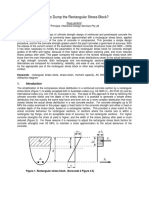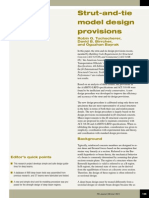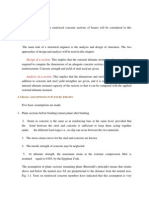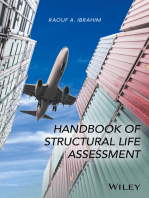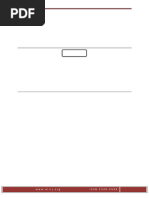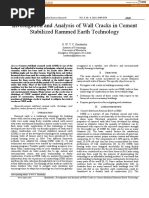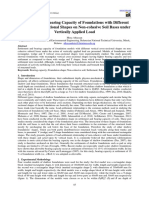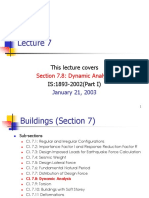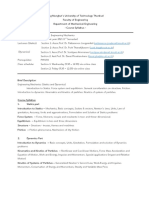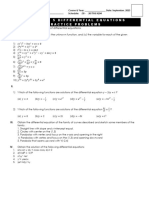TV 27 2020 6 2008-2015
TV 27 2020 6 2008-2015
Uploaded by
ksshashidharCopyright:
Available Formats
TV 27 2020 6 2008-2015
TV 27 2020 6 2008-2015
Uploaded by
ksshashidharOriginal Title
Copyright
Available Formats
Share this document
Did you find this document useful?
Is this content inappropriate?
Copyright:
Available Formats
TV 27 2020 6 2008-2015
TV 27 2020 6 2008-2015
Uploaded by
ksshashidharCopyright:
Available Formats
ISSN 1330-3651 (Print), ISSN 1848-6339 (Online) https://doi.org/10.
17559/TV-20190709112144
Preliminary communication
Reinforcement Calculation of Circular and Annular Cross Section
Yao KAICHENG, Zhou DONGHUA*, Shuang CHAO, Lan SHUWEI, Chen JIN
Abstract: Circular and annular cross-section is one of the more common cross-section forms, such as water towers, piers, etc. But reinforcement calculation of these cross-
sections is dual, the nonlinearity in width change and the nonlinear stress-strain relationship of concrete and reinforcement, which brings inconvenience to the calculation.
In this paper, the corresponding calculation formulas are analytically derived and practical design charts (nomograms) are obtained. Based on stress-stain curve of concrete
and reinforcement, five strain distribution regions were constructed. Via strains stress can be determined and then via the stress internal force can be computed, without
application of the traditional equivalent rectangular stress block in concrete compression zone. The obtained dimensionless design charts can be applied to all load cases,
such as uniform tension, tension with a small and large eccentricity, pure bending, compression with a large and small eccentricity and uniform compression. The calculation
by using the design charts is simple and quick.
Keywords: axial and eccentric load; circular and annular cross-section; dimensionless design charts; reinforcement ring; strain region
1 INTRODUCTION
c ( c 0.25 c ) fc
2
(0 > c 2.0‰)
(1)
Members with circular or annular section shapes have c fc (2.0‰ c 3.3‰)
low resistance to fluid (wind, water) and are commonly
used in engineering structures, such as piers, water towers, s Es s (0 < s y )
etc. Analytical calculating reinforcement area of the (2)
circular and annular cross sections is generally needed to s y ( y s 10‰)
solve transcendental equations, which are provided in
some specifications, for example in chinses code [1-2]. where c is strain of concrete and s strain of
Nevertheless the application of these equations shows
reinforcement. The ultimate strain limit of concrete and
some shortcomings:① solutions can only be iteratively
reinforcement is −3,3‰ and 10‰ respectively.
solved with software and cannot be computed by hand, and
this is inconvenient for practice; ② The transcendental
equations are derived often with strong simplifications
(e.g. in reference 1), which make the scope of application
limited and it is applicable only when the neutral axis is
within the cross section. For example, in the reference [3,
4, 14-19], the authors derived the formulas, which are all
based on the equivalent rectangular stress block. Among
them some are obtained analytical formulas [16-19] and
some others are numerical calculations [14, 15]. To Figure 1 Constitutive relation (a) concrete,(b) reinforcement
overcome these shortcomings some design chats are made
in this paper for quick calculating reinforcement area or for It should be noted that all strain values take the values
checking strength of the circular and annular cross before the symbol of per thousand, i.e. are not divided by
sections. For more accuracy instead of the rectangular 1000.
stress block, the stress-strain curves of concrete and
reinforcement adopted in reference 1are applied to derive 2.2 Division of the Whole Possible Strain Distributions Into
formulas. Although nowadays computers are widely used, 5 Strain Regions
quick calculation tools to determine reinforcement area of
circular and annular cross sections are still needed and The main process of the method in the paper is
welcome, which enable a hand calculation not only for variation of possible strains distributions of cross section,
quick determining reinforcement area, but also for quick and then via the strains corresponding stresses can be
checking the results computed by computer. valued according to constitutive curves of concrete and
reinforcement and finally the internal forces are computed.
2 THE METHOD, DERIVATION AND DESIGN CHARTS Therefore, it is necessary to know how and in which region
2.1 Stress-Strain Relationship of Concrete and the strain distributions can be changed. Based on the stress-
Reinforcement strain curves in Fig. 1 the strain distributions of cross
section can be divided into five strain regions as shown in
The following stress-strain curves of concrete and Fig. 2. Within each strain region there are always strains on
reinforcement are used and shown in Fig. 1. one side (top section edge or bottom reinforcement) fixed
The mathematical expression of the constitutive curves in the ultimate strain limit state, and on the other side the
in Fig. 1 is given as the following: strains can be varied, thus it can be ensured that all strain
distributions are in the ultimate limit state, and this means:
2008 Technical Gazette 27, 6(2020), 2008-2015
Yao KAICHENG et al.: Reinforcement Calculation of Circular and Annular Cross Section
the section can be assumed either tensile failure, or counterclockwise around point A to the vertical position
compression failure, or balanced failure occurred [4-13]. (point A can be calculated from the geometric relationship
After dividing the whole possible strain distributions with respect to the top and bottom edge strains). The top
into 5 regions, the strains become now known, and then the edge strain of the cross section reduces from −3,3‰ to
corresponding stresses can be determined via the −2,0‰ and the bottom edge strain increases from 0,0‰ to
constitutive relationships of concrete and reinforcement. −2,0‰ simultaneously, and the curvature decreases to zero.
By integration of the stresses over the cross section the The load cases of the region may be compression with a
internal normal forces and bending moments can be small eccentricity and uniform compression.
obtained. So far, the five divided strain regions contain all
The characteristics of each strain region are briefly possible strain distributions and cover all load cases known
described as follows: as uniform tension, tension with a small and large
eccentricity, pure bending, compression with a large and
small eccentricity and uniform compression. It is incidental
to note that in regions ② and ⑤ the top edge strains of the
cross section are variable and hence the equivalent
rectangular stress block cannot be applied.
2.3 Computation Cross Section Stress and Internal Force
Using the geometric relationship of the strain
Figure 2 Strain change region of concrete and reinforcement
distribution in Fig. 3 the depth of the compression zone x
can be calculated:
Region ①: Holding the bottom strain of reinforcement
at the value of s 10‰ , the top edge strain of the cross c1
x d (3)
section can be varied ( c1 10 ~ 0‰ ). Since the full cross c1 c 2
section being in tension, the tensile strength of concrete is
neglected, and the tension force in cross section is carried When x is obtained, it is able to determine the strain ci at
out only by reinforcement. At the left boundary of the
region the strain distribution represents uniform tension, at any fiber within the cross section.
which the values of the steel strain on both sides reach the
value of s 10‰ and the corresponding curvature is 0. z
ci c1 (4)
The load cases of the region may be uniform tension, x
tension with a small eccentricity, and the curvature
increases gradually from zero. where z can be obtained from neutral depth x subtracting
Region ②: Keeping the bottom strain of reinforce- chord height of the circle hi, see Eq. (5)
ment fixed at the value s 10‰ , and the top edge strain
of concrete continuing varied with the value
c1 0 ~ 3,3‰ , the neutral axis moves into the cross
section and the curvature increases further. When the top
edge strain reaches c1 3,3‰ , the curvature becomes
the maximum. The load cases of the region may be tension
or compression with eccentricity.
Region ③: Fixing the top edge strain at the value of
c1 3,3‰ , and the bottom strain of reinforcement can
be varied with the value s 10‰ ~ y . As the bottom
Figure 3 Section parameters and strain
strain gradually decreases, the neutral axis moves down,
and the depth of the compression zone increases and the
curvature decreases. The load cases of the region may be The chord height hi r 1 cos reaches the
pure bending and compression with a large eccentricity. minimum of zero at the top of the circle, and the maximum
Region ④: the top edge concrete strain keeping on of 2r at the bottom of the circle.
fixed at the value c1 3,3‰ , the bottom reinforcement
strain continues to decrease and even enters the z x hi x r 1 cos (5)
compression zone, until the bottom edge strain of concrete
reduces to c2 0 . The neutral axis reaches the bottom In Eq. (5) variables x and hi are independent, x varies
edge of the cross section and the curvature is reduced with the cross section edge strain, but hi varies with central
further. The load cases of the region may be compression angle , which increases from top to bottom of the circle.
with a small eccentricity. If x is fixed, z varies only with the chord height, and hence
Region ⑤: This region is a swept region where the varies also with the central angle , thus the strain of any
right boundary line of the region ④ is rotated
Tehnički vjesnik 27, 6(2020), 2008-2015 2009
Yao KAICHENG et al.: Reinforcement Calculation of Circular and Annular Cross Section
fiber can be described as a function of the central angle. x x
0 ci ( )b( )dy 2r 0 ci ( )sin
2 2
Nc2 d
Substituting value z of Eq. (5) into Eq. (4).
K
x
2r 2 1 K 2 cos K 3 cos 2 sin 2 d
x r 1 cos 0
ci c1 (6) sin2 sin 3
j 1
x (10)
K1 K2
2 4 3
2 fc r 2
and then substituting value ci of Eq. (6) into Eq. (1), the 3
sin cos sin2
stress of any fiber can be calculated. 4 8 16 j
ci ( ) ( ci 0.25 ci2 ) f c x
M c 2 ci ( )b ( ) rcos dy
r 2 2
r 0
1 c1 1 c1 x
x 4 x
2 r 3 ci ( )sin 2 cos d
0
K1
K1 K 2 cos K 3cos sin cos d
x
fc (7) 2r 3 2 2
r r 1 c1 r cos r c1 cos 2
2 2 2 0
x x 2 c1 j 1 (11)
x x 2 4 sin 3 sin cos 3 sin2
K1 K2
K 2
K3
3 4 8 16
2 fc r 3
K1 K 2 cos K 3 cos 2 f c sin cos sin sin K
4 3
5 5 15
3
j
After getting the expression of stress, the stress can be
integrated over the cross section to obtain the internal axial Obviously, the axial force and bending moment
force and bending moment. The calculated bending obtained above are dependent on concrete strength and size
moment is about the horizontal centroid axis of the circle. of cross section. In order to get a more general
For easy calculation, the stress block in Fig. 4 should be dimensionless expression, Eq. (8) and Eq. (10) should be
divided into two parts, one part consisting of rectangle and
divided by πr 2 f c and Eq. (9) and Eq. (11) by πr 3 f c
another of parabola.
respectively, and then the dimensionless axial force and
bending moment are obtained as follows:
2 j
nc1 π 0 .5sin 2 0
m 2 sin 3 j
c1 3π 0
sin 2 sin 3 j 1
K1 K2
2 2 4 3
nc 2 π
sin cos 3
sin 2 (12)
Figure 4 Strain and stress distribution (rectangle and parabola)
4 8 16
j
2.3.1 Rectangular Stress Block (εc1 =−2.0‰ −3.3‰)
sin 3 sin cos 3 sin 2 j 1
K1 K 2
The concrete stress is constant, and the axial force and m 2 3 4 8 16
c2 π 3
bending moment can be computed by integration of stress sin cos 4
sin
sin
K3
over the cross section, as shown in Eq. (8) and Eq. (9). 5 5 15
j
x x
0 f c b ( )d y 2 r f c sin 2 d
2
N c1 It is to note that the values of integral interval of Eq.
0
j (8) (12) have not been determined. Their determination
sin 2
2 fc r 2 depends on the shape of the stress blocks, which can be
2 4 0 varied and result in the following 4 stress block shapes:
x
M c1 0 f c b ( ) r cos d y
x 2 j (9)
2 r 3 f c sin 2 cos d f c r 3 sin 3
0 3 0
Figure 5 Shape cases of the concrete stress block
2.3.2 Parabolic Stress Block (εc1 = 0‰ −2.0‰)
① a partial parabola; ② a full parabola; ③ a full
Since the strains in this part are variable and the
parabola + a partial rectangular block; ④ a full parabola +
stresses are accordingly not constant, their values can be
determined by Eq. (7). After integration of stress the full rectangular block.
corresponding axial force and bending moment can be Taking case ① as an example, the stress distribution is
obtained. a partial parabola (see Fig. 5 and Fig. 6), and the strain
2010 Technical Gazette 27, 6(2020), 2008-2015
Yao KAICHENG et al.: Reinforcement Calculation of Circular and Annular Cross Section
increases gradually from zero (0 > εc1 > −2,0‰). The continuously distributed, that is, the total area of the
integral interval begins from the top point of the circle to reinforcement is distributed on the circumference of
the neutral axis, which correspond a central angle, and its reinforcement ring having a radius rs.
value can be calculated by Eq. (13).
As
as (14)
i arccos( q ) 2πrs
(13)
q ( r hi ) / r
The magnitude of the central angle is dependent on the
corresponding chord height hi, which varies with the stress
block shape and size. For example, an angle can be
calculated by substituting a chord height shown in Fig. 6
into Eq. (13). At the top point of the circle the chord height
is zero, and at the neutral axis is x.
Taking Case ③ as another example, the stress block
shape consists of a full parabola + a partial rectangular Figure 7 Strain and stress of reinforcement ring
block (see Fig. 5 and Fig. 4), and its strain range is
−2,0‰ > εc1 > −3,3‰. The whole integral interval is to be Hereinafter, the continuously distributed reinforce-
divided into two intervals (a rectangular part and a ment is referred to as a reinforcement ring. The stress block
parabolic part). The 1st interval starts from top point of the of the reinforcement ring (Fig. 7) can be also divided into
circle and ends at the junction point between rectangular two parts, one is a rectangular stress block (plastic zone)
and parabolic stress block. The 2nd interval starts from and another is a triangular stress block (elastic zone). The
junction point mentioned above and ends at the neutral axis. internal forces of the two stress blocks are calculated
The chord heights of three boundary points are 0, x − a and separately below.
x, and their q - values are 1, r x a / r and r x / r
2.4.1 Rectangular Stress Block (Plastic Zone)
respectively.
In this part, the stress of the reinforcement ring is
constant, and the calculation of the axial force and the
bending moment is actually the calculation of area and area
moment, as shown in Eq. (15) and Eq. (16).
N s1 2 f y as rs d 2 f y as rsc 0 j (15)
Figure 6 The upper and lower limits of the integral corresponding to the M s1 2 f y as rs cos rs d
central angle (partial parabola) (16)
2 f y as rs2 cos d 2 f y as rs2 sin 0 j
Different strain regions result in different stress block
shapes, and they can be summarized into three stress block
shapes and their q - values can be calculated according to 2.4.2 Triangular Stress Block (Elastic Zone)
Tab. 1.
The strain and stress of the reinforcement ring at any
Table 1 The q - values of boundary points of three concrete stress diagrams fiber of cross section are:
region② region②③④ region⑤
j 0 > εc1 >−2,0 −2,0 > εc1 > −3,3 −2,0 > εc1 > −3,3 x (r rs cos )
(Interval si c1 (17)
points of x
integral)
x (r rs cos )
1 q 1 q 1 q 1 si Es si Es c1 (18)
rx r ( x a) r ( x a)
x
2 q q q
r r r
The resulting axial force in elastic zone can be
rx
3 - q q 1 obtained by integrating stress.
r
x (r rs cos)
2.4 Calculation of Stress and Internal Force of Ns2 2 si as rs d 2Es as rs c1d
Reinforcement Ring x
(19)
rs
2Es as c1 (x r) rssin j 1
The reinforcement is usually discretely distributed, x j
which makes it inconvenient for calculation. For easy
calculation, the reinforcement can be assumed to be
Tehnički vjesnik 27, 6(2020), 2008-2015 2011
Yao KAICHENG et al.: Reinforcement Calculation of Circular and Annular Cross Section
The resulting bending moment in elastic zone can be a partial triangle; ② a full triangle; ③ a full triangle + a
obtained by integrating stress multiplying lever arm about
the horizontal center axis of the circle. partial rectangle; ④ a full triangle + a full rectangle;
Different strain regions have different stress shapes; they
M s 2 2 si as rs2 cos d can be summarized into three cases. The calculation of q -
values in each case can be carried out as shown in Tab. 2.
x (r rs cos )
2 Es as rs2 c1cos d
x (20) 2.5 Calculation of Reinforcement of Annular Section
j 1
rs2 sin2
2 E s as c1 ( x r )sin rs The calculation of the annular cross section is basically
x 2 4 j the same as that of the circular cross section. The only
difference is that it should be treated a little by calculating
For easy using, it is better to employ the dimensionless the internal force of the concrete, i.e. the compression area
internal force and bending moment. Therefore Eq. (15) and of the small circle (inner circle) must be subtracted from
the area of the large circle (outer circle) (see Fig. 9).
Eq. (19) are divided by πr 2 f c , and Eq. (16) and Eq. (20)
by πr 3 f c ,
s j
ns1 0
m s rs sin j
s1 r 0
s Es c1 j 1 (21)
ns 2 f x ( x r ) rs sin j
y
j 1 Figure 9 Compression zone of annular section
m s Es c1 rs ( x r )sin r sin2
s2
f y x r s
2 4 j Hereto all formulae have been derived. The main idea
of the method is to determine stress according to possible
where ωs is mechanical reinforcement ratio defined by: strain distributions in ultimate limit state, which are
divided into 5 regions based on stress-strain relationship of
concrete and reinforcement from Chinese Code. And then
As f y integration of stress results in axial force and bending
s (22)
πr 2 f c moments.
Based on the five strain regions (see Fig. 2), the strains
The determination of the integral points in Eq. (21) is of concrete and reinforcement, as well as the areas of the
similar to that of concrete described before. Depending on reinforcement are varied. The corresponding
the stress block shape of the reinforcement ring there are dimensionless internal forces and bending moments are
also four cases shown in Fig. 8: calculated. For practice usage, i.e. a quick calculating the
reinforcement area of circular and annular cross section, all
calculated values by using derived formulae are drawn into
the design charts (nomograms) in Fig. 10. It is no need to
solve iteratively transcendental equations given in the
Chinese Code to get reinforcement area of circular and
annual cross section. In addition some useful information
Figure 8 Shape cases of stress block of the reinforcement ring can be obtained from Fig. 10:
(1) The balanced failure point of the circular cross section
Table 2 The q-values of boundary points of three stress diagrams of
reinforcement ring
is no longer at the point of the maximum bending moment,
region①② region②③④ region④⑤ while the balanced failure point of rectangular cross section
j εc1 > −2,0 −2,0 > εc1 > −3,3 −2,0 > εc1 > −3,3 indicates the maximum bending moment.
(interval
points of (2) The innermost curve of circular cross section ( s =0.0 )
integral) represents m − n interaction curve of pure concrete having
1 q 1 q 1 q 1 no reinforcement. Since the tensile strength of concrete is
neglected, the curve is located above the horizontal axis
r ( x a) r ( x a) r ( x a)
2 q q q and i.e. in the compression-bending zone. The other
rs rs rs
remaining m − n curves having reinforcement begin to
r ( x a) expand from the innermost curve. Therefore the graphic
3 q 1 q q 1
rs
area above the horizontal axis is larger than that below the
4 - q 1 - horizontal axis, in other words, the compression-bending
zone is larger than the tension-bending zone. If the tensile
stress of concrete was taken into account, the whole m −
2012 Technical Gazette 27, 6(2020), 2008-2015
Yao KAICHENG et al.: Reinforcement Calculation of Circular and Annular Cross Section
ninteraction curves would be symmetrical to the horizontal HRB400, fy = 360. For comparison, the calculations were
axis. carried out according to the method of this paper and in the
(3) Comparing Fig. 10a with Fig. 10b, it is easy to see the reference [1] respectively. The transcendental equations
difference that the curve of the innermost ( s =0.0 ) of the given in reference [1] for determining the reinforcement
annular section is significantly reduced, and the whole area of circular cross section are:
remaining curves in the compression-bending zone above
the horizontal axis are also reduced, while those curves in sin2π
the tension-bending zone below the horizontal axis are N fc A1 2π t f y As
almost not changed. That means, the lack of core concrete 2 3
sin π sinπ sinπt
area has a great influence on compression-bending bearing M fc Ar f y As rs (23)
capacity of the cross section and has little effect on the 3 π π
tension-bending bearing capacity.
t 1.25 2
3 EXAMPLES
In order to demonstrate the application of the where A and As are cross section area and total area of
nomogram above, a circular section subjected to seven load reinforcement respectively. The angle α in Fig. 11 is
cases is selected, and the cross section parameters for all expressed in radians.
load cases are: r = 250 mm, as = 37,50 mm, C40, fc = 19,1;
Figure 10 Nomogram of calculating reinforcement of circular and annular section
The results calculated by both methods are shown in
Tab. 3.
Comparing the calculation results of the two methods
gives the following:
(1) 7 load cases in Tab. 3 can be easily calculated by using
the design chart in Fig. 8. The calculation is very simple.
Besides the determined reinforcement areas, the additional
information such as strain distribution and strain region
being able to be roughly determined for each load case can
Figure 11 Cross section be also obtained,
Tehnički vjesnik 27, 6(2020), 2008-2015 2013
Yao KAICHENG et al.: Reinforcement Calculation of Circular and Annular Cross Section
(2) Only 3 load cases in Tab. 3 could be solved by applying no solution obtained, because Eq. (23) is derived based on
transcendental Eq. (23), which shows a good agreement the fact that the neutral axis is located within the section.
with those of method 1, For remaining 4 load cases there is
Table 3 Calculation of Example 1 - 7 using Fig. 10 of the Method 1 and using Eq. (23) of the method 2
①
Method 1 ②
N / M / N M
Example Load cases n m c1 / s s r2 Method 2 ②/①
kN kNm 2
πr fc πr 3 fc As s
f y / fc As / cm2
/ cm2
1 uniform compression −8250 0,0 −2,20 0,00 −2,00/−2,00 1,20 12501 - -
compression with a
2 −6750 187,5 −1,80 0,20 −2,98/−0,50 1,12 11668 - -
small eccentricity
compression with a
3 −1500 843,8 −0,40 0,90 −3,30/+2,78 1,40 14584 14112 0,967
large eccentricity
4 pure bending 0,0 562,5 0,00 0,60 −3,30/+5,50 0,93 9688 9478 0,978
tension with a large
5 +1500 843,8 0,40 0,90 −3,30/+7,50 1,70 17710 17455 0,985
eccentricity
tension with a small
6 +6000 93,75 1,60 0,10 +1,50/+10,0 1,71 17814 - -
eccentricity
7 uniform tension +3750 0,0 1,00 0,00 +10,0/+10,0 1,00 10417 - -
4 CONCLUSIONS [2] Shi, L. Q. & Zhang, Y. X. (1991). Study Guide for concrete
structure design guide. Beijing, Earthquake Press.
A method and the corresponding equations for [3] Yuan, F. & Yang, R. C. (1997). Theoretical formula and
graphic solution for reinforcement calculation of columns
calculating the reinforcement of circular and annular cross
with circular cross section. Journal of Nanjing Institute of
section is presented. Derivation of the equations is strictly architecture and Engineering, 1(1), 13-23.
based on the stress-strain relationship of concrete and [4] Wu, D. (2002). Concrete structure calculation
reinforcement used in reference [1], which can be easily manual.Beijing, China Architecture Building & Press.
replaced by another stress-strain relationship of concrete [5] Zhou, D. H. & WANG, Q. F. (2010).A new method for the
and reinforcement given in Eurocode 2 or in ACI 318. calculation of reinforcement of concrete: General
Dimensionless design charts - a useful tool for quick dimensionless designing diagram. Engineering Mechanics,
calculating reinforcement area of circle and annular cross 27(1), 165-172. https://doi.org/10.3901/JME.2004.01.165
section, are made. These design charts can be applied to all [6] Zhou, D. H. & Cheng, H. M. (2007). A new kh0-method for
7 load cases, such as uniform tension, tension with a small calculation of singly reinforced concrete beam.Engineering
Mechanics, 24(12), 106-112.
and large eccentricity, pure bending, compression with a [7] Zhou, D. H., Cheng, H. M., etc. (2008). A new kh0-method
large and small eccentricity and uniform compression, In for calculation of doubly reinforced concrete beam.
addition, the design charts provide some other information, Engineering Mechanics, 25(2), 188-192.
such as strain distribution, area of 5 strain regions, [8] EN1992 Eurocode 2. (2004). Design of concrete structures.
balanced failure point. Berlin,Beuth Verlag GmbH.
The core of the method is using strains to solve the [9] DIN 1045-1. (2008). Tragwerke aus Beton: Stahlbeton und
stresses and then using stresses to solve the internal forces. Spannbeton. Berlin, Beuth Verlag GmbH.
After the all possible strain regions are determined in Fig. [10] BS 8110-1. (1997). Structural use of concrete, Part 1: Code
2, the strains become known variables, which can be given of practice for design and construction. London, UKBSI.
[11] Wieland, R. (2000). Vorlesungsscript für Massivbau und
with different values and substituted into the relevant Baukonstruktion. Universität Kaiserslautern,Germany.
formulas. The stresses and internal forces can be finally [12] Klaus, J. S. (2002). Bautabellen für Ingenieure. 15. Aufl.,
obtained. Düsseldorf, Werner Verlag.
Fig. 10 is only applicable to ordinary concrete with [13] Tompert, K. (1971). Bemessung von Kreisquerschnitten und
grades C15 - C50, because their ultimate strains have the Kreisringquerschnitten nach dem Traglastverfahren.
same value of 3.3‰. The ultimate strains of high-strength Bauingenieur, 46(3), 90-97.
concrete (grades > C50) do not have the same constant [14] Gu, D. S., Wu, G., & Wu, Z. S. (2012). Calculation of the
value, so the design charts need to be recalculated and ultimate flexural capacity of normal section of reinforced
circular columns. Engineering Mechanics, 29(8), 227-235.
recreated, but the formulas derived in this article are still
[15] Wu, M. J. & Chen, S. Y. (2010). Study on simplified method
applicable. of reinforcement calculation of circular section flexural
members of reinforced concrete. Building Structure, 40(10),
Acknowledgements 102-104.
[16] Hsiao, K. J. (2012). Bending-Axis Effects on Load-Moment
This work was financially supported by the National (P-M) Interaction Diagrams for CircularConcrete Columns
Natural Science Foundation of China (51668027 and Using a Limited Number of Longitudinal Reinforcing Bars.
51468026), Electronic Journal of Structural Engineering, 12(1), 10-16.
[17] Quaranta, G.,Trentadue, F., & Marano, G. C.(2017). Closed-
form approximation of the axial force-bending moment
5 REFERENCES
interaction diagram for hollow circular reinforced concrete
cross-sections. Engineering Structures, 153(12), 516-524.
[1] GB 50010. (2003).Code for design of concrete structures.
https://doi.org/10.1016/j.engstruct.2017.10.042
Beijing, China Planning Press. (in Chinese).
2014 Technical Gazette 27, 6(2020), 2008-2015
Yao KAICHENG et al.: Reinforcement Calculation of Circular and Annular Cross Section
[18] Peng, K., Wang, Y.Q., Zou, Q., & Liu, Z. (2019). Effect of
crack angles on energy characteristics of sandstones under a
complex stress path. Engineering Fracture Mechanics,
218(7), 1-11. https://doi.org/10.1016/j.engfracmech.2019.106577
[19] Du, P. W., Gan, D., Yang, Y. W., & Tan, K. H. (2019).
Simplified method for analysis of circular steel tubed-
reinforced-concrete columns under eccentric compression.
Engineering Structures, 198(11).
https://doi.org/10.1016/j.engstruct.2019.109524
Contact information:
Yao KAICHENG, PhD
Faculty of Civil Engineering and Mechanics, Kunming University of Science and
Technology,
727 South Jingming Road, Chenggong District, Kunming, Yunnan 650500, China
E-mail: ykc041430@qq.com
Zhou DONGHUA, Prof., PhD
(Corresponding author)
Faculty of Civil Engineering and Mechanics, Kunming University of Science and
Technology,
727 South Jingming Road, Chenggong District, Kunming, Yunnan 650500, China
E-mail: 806029639@qq.com
Shuang CHAO, PhD Postgraduates
Faculty of Civil Engineering and Mechanics, Kunming University of Science and
Technology,
727 South Jingming Road, Chenggong District, Kunming, Yunnan 650500, China
E-mail: 1403094948@qq.com
Lan SHUWEI, PhD Postgraduates
Faculty of Civil Engineering and Mechanics, Kunming University of Science and
Technology,
727 South Jingming Road, Chenggong District, Kunming, Yunnan 650500, China
E-mail: 420113261@qq.com
Chen JIN, Assoc. Prof., MSc.
Faculty of Civil Engineering and Mechanics, Kunming University of Science and
Technology,
727 South Jingming Road, Chenggong District, Kunming, Yunnan 650500, China
E-mail: chen40333@yahoo.com.cn
Tehnički vjesnik 27, 6(2020), 2008-2015 2015
You might also like
- The Effect of Flexural Rigidity On The Moment and Deflection of Statically Indeterminate Reinforced Concrete ElementsDocument8 pagesThe Effect of Flexural Rigidity On The Moment and Deflection of Statically Indeterminate Reinforced Concrete ElementsShyam AwalNo ratings yet
- Fig P11-01Document2 pagesFig P11-01Fernando Pauli PradoNo ratings yet
- Module Exercise Mega 1Document85 pagesModule Exercise Mega 1Andrea Magtuto100% (1)
- 7 Elastic Analysis of Beams For Serviceability Limit StateDocument8 pages7 Elastic Analysis of Beams For Serviceability Limit StateFitsum AbebeNo ratings yet
- Modelling Deflection in Reinforced Concrete Structures Using The Layered ApproachDocument21 pagesModelling Deflection in Reinforced Concrete Structures Using The Layered ApproachMohamed mohy el deenNo ratings yet
- 028 CCC 2014 NavratilDocument6 pages028 CCC 2014 NavratilkstayroskNo ratings yet
- Plastic Moment Redistribution 2011Document11 pagesPlastic Moment Redistribution 2011Abuye HD100% (1)
- Short Course Deflection OHP Circulated Post CourseDocument97 pagesShort Course Deflection OHP Circulated Post CourseMartin CibulkaNo ratings yet
- 2) Introduction To WSD, Rectangular BeamsDocument10 pages2) Introduction To WSD, Rectangular BeamsVanessa Rosal PalerNo ratings yet
- Analysis of Composite Beams Widely Spaced ConnectorsDocument3 pagesAnalysis of Composite Beams Widely Spaced ConnectorsJames O'HaraNo ratings yet
- 1984 WycheDocument15 pages1984 WychetomNo ratings yet
- Intro-Rcd NotesDocument6 pagesIntro-Rcd NotesRam CaniculaNo ratings yet
- 028 CCC 2014 NavratilDocument7 pages028 CCC 2014 NavratilBogdanBNo ratings yet
- Rcs - Ii Plastic Moment Redistribution: Figure 1.2-1 CurvatureDocument67 pagesRcs - Ii Plastic Moment Redistribution: Figure 1.2-1 Curvaturemoha sher100% (1)
- Chapter 3-Strut-and-Tie ModelDocument91 pagesChapter 3-Strut-and-Tie ModelAntenehNo ratings yet
- Fatigue Behaviour of Thin Walled Cold Formed Steel ProfilesDocument11 pagesFatigue Behaviour of Thin Walled Cold Formed Steel ProfilesFarhan DanishNo ratings yet
- Cie 525Document12 pagesCie 525Richard PadillaNo ratings yet
- Time Saving-Two Way2Document9 pagesTime Saving-Two Way2Wanda Beasley100% (1)
- 31 (2) 0073Document12 pages31 (2) 0073ccorreaicNo ratings yet
- CONCRETE 2011 Stress Block3 PDFDocument9 pagesCONCRETE 2011 Stress Block3 PDFThong NguyenNo ratings yet
- CIV6235 - Shear (MG)Document26 pagesCIV6235 - Shear (MG)friendycalls100% (1)
- Chapter 3Document18 pagesChapter 3gossayeNo ratings yet
- ACI 533-5R-20 Guide For Precast Concrete Tunnel Segmentes Parte 2-2Document47 pagesACI 533-5R-20 Guide For Precast Concrete Tunnel Segmentes Parte 2-2Mapeix100% (1)
- 1 PDFDocument4 pages1 PDFMuhammad Adeel ArshadNo ratings yet
- Coventry University MSC Bridge Engineering Module Differential Shrinkage and Creep of Composite SlabDocument6 pagesCoventry University MSC Bridge Engineering Module Differential Shrinkage and Creep of Composite Slabaggrey noahNo ratings yet
- Design Procedure For Steel Column Bases With Stiff PDFDocument8 pagesDesign Procedure For Steel Column Bases With Stiff PDFAchilles TroyNo ratings yet
- Beams 3Document18 pagesBeams 3AlkhaledNo ratings yet
- Deflection in Concrete BeamsDocument10 pagesDeflection in Concrete BeamsMunish GaurNo ratings yet
- Design of Shear Reinforcement For Timber BeamsDocument16 pagesDesign of Shear Reinforcement For Timber BeamsUlrich HübnerNo ratings yet
- Deflection in Concrete BeamsDocument6 pagesDeflection in Concrete BeamsJay PatelNo ratings yet
- Effect of Differential Creep and Shrinkage On Prestressed Composite Concrete SectionsDocument15 pagesEffect of Differential Creep and Shrinkage On Prestressed Composite Concrete SectionsThomas WilsonNo ratings yet
- Tension StiffeningDocument13 pagesTension StiffeningRahul BhatiaNo ratings yet
- 3.2. Tensile Strength of ConcreteDocument21 pages3.2. Tensile Strength of ConcreteMacovei AlinNo ratings yet
- Softened Truss Model For RC Torsional Members Under Combined ActionDocument8 pagesSoftened Truss Model For RC Torsional Members Under Combined ActionMinaksheePhutkeNo ratings yet
- RC Ii0001Document102 pagesRC Ii0001TESFAYENo ratings yet
- Design of Rigid Frame Bridges (With Diagram)Document9 pagesDesign of Rigid Frame Bridges (With Diagram)Pacha Khan KhogyaniNo ratings yet
- Chapter Three - TorsionDocument34 pagesChapter Three - Torsioneyuleme146No ratings yet
- Strut-And-Tie Model Design Provisions: Robin G. Tuchscherer, David B. Birrcher, and Oguzhan BayrakDocument16 pagesStrut-And-Tie Model Design Provisions: Robin G. Tuchscherer, David B. Birrcher, and Oguzhan BayrakDavid Apaza QuispeNo ratings yet
- Design of A Section.: NtroductionDocument12 pagesDesign of A Section.: NtroductionM Nur SalimNo ratings yet
- Bracing of Steel-Concrete Composite Bridge During Casting of The DeckDocument12 pagesBracing of Steel-Concrete Composite Bridge During Casting of The Deckparvaneh.eNo ratings yet
- 3 - STRESS RAISE - 1995 - Stress Determination For Fatigue Analysis of Welded Co PDFDocument7 pages3 - STRESS RAISE - 1995 - Stress Determination For Fatigue Analysis of Welded Co PDFMANHAL KHRIAMANo ratings yet
- Design of Rigid Frame Bridges (With Diagram)Document9 pagesDesign of Rigid Frame Bridges (With Diagram)Pacha Khan KhogyaniNo ratings yet
- Shear Behaviour of InterfacesDocument10 pagesShear Behaviour of InterfacesbelleblackNo ratings yet
- ENSC 3008 Lecture Notes 2016Document316 pagesENSC 3008 Lecture Notes 2016richard4handokoNo ratings yet
- Strut and Tie LectureDocument9 pagesStrut and Tie LectureNAUTILUS87No ratings yet
- rc-1 2015-16 Chapter Two 141215Document36 pagesrc-1 2015-16 Chapter Two 141215ABAMELANo ratings yet
- Punching Shear Resistance of Reinforced Concrete Slabs Without Punching Shear ReinforcementDocument13 pagesPunching Shear Resistance of Reinforced Concrete Slabs Without Punching Shear ReinforcementYusuf Ali SamiNo ratings yet
- IJIRT161588 - PAPER - Crack Width Calculation of ColumnsDocument5 pagesIJIRT161588 - PAPER - Crack Width Calculation of ColumnsS DuttaNo ratings yet
- T.7.7.6 Shrinkage Curvature: RAPT User ManualDocument16 pagesT.7.7.6 Shrinkage Curvature: RAPT User Manualtailieuxaydung2019No ratings yet
- Simplification of Softened Strut-and-Tie Model For Strength Prediction of Discontinuity RegionsDocument11 pagesSimplification of Softened Strut-and-Tie Model For Strength Prediction of Discontinuity Regionsyjy980425No ratings yet
- Thesis Pile Cap 3Document15 pagesThesis Pile Cap 3bntt2023No ratings yet
- Evaluate The Capability and Accuracy of Response-2000 Program in Prediction of The Shear Capacities of Reinforced and Prestressed Concrete MembersDocument12 pagesEvaluate The Capability and Accuracy of Response-2000 Program in Prediction of The Shear Capacities of Reinforced and Prestressed Concrete MembersRohadi HashimNo ratings yet
- Figure 1 Example of D-Regions in A Common Building StructureDocument13 pagesFigure 1 Example of D-Regions in A Common Building StructureCristobal Jimenez MuchoNo ratings yet
- Design - Concept - For - Bolted Glass - Baitinger MaschaDocument10 pagesDesign - Concept - For - Bolted Glass - Baitinger MaschaNatalia KrivonogovaNo ratings yet
- Lecture 8Document13 pagesLecture 8Pankaj105No ratings yet
- JL 07 September October 5 Part5Document1 pageJL 07 September October 5 Part5linghuchongNo ratings yet
- Chapeter 5Document25 pagesChapeter 5ashenafiNo ratings yet
- Design For Flexure-WsdDocument10 pagesDesign For Flexure-WsdRichard TagleNo ratings yet
- 883_2016-timber-designDocument29 pages883_2016-timber-designksshashidharNo ratings yet
- 456A2Document2 pages456A2ksshashidharNo ratings yet
- 1161A1Document1 page1161A1ksshashidharNo ratings yet
- Onduline Fixing GuideDocument7 pagesOnduline Fixing GuideksshashidharNo ratings yet
- 1 s2.0 0307904X9090088M MainDocument10 pages1 s2.0 0307904X9090088M MainksshashidharNo ratings yet
- 38Document4 pages38ksshashidharNo ratings yet
- U Bar-Column Beam JunctionDocument3 pagesU Bar-Column Beam JunctionksshashidharNo ratings yet
- Silo&Bins TheoryDocument36 pagesSilo&Bins Theoryksshashidhar100% (1)
- Govpub C13Document20 pagesGovpub C13ksshashidharNo ratings yet
- Investigation and Analysis of Wall Cracks in Cement Stabilized Rammed Earth TechnologyDocument6 pagesInvestigation and Analysis of Wall Cracks in Cement Stabilized Rammed Earth TechnologyksshashidharNo ratings yet
- Concrete Construction Article PDF - Installing Weep HolesDocument2 pagesConcrete Construction Article PDF - Installing Weep HolesksshashidharNo ratings yet
- Only For Reference - Exisiting Silo GaDocument1 pageOnly For Reference - Exisiting Silo GaksshashidharNo ratings yet
- Appendix A: S.X., - , - He A RDocument53 pagesAppendix A: S.X., - , - He A RksshashidharNo ratings yet
- GRP in Bypass Conditions and Temperatures Up To 300 CDocument20 pagesGRP in Bypass Conditions and Temperatures Up To 300 CksshashidharNo ratings yet
- JB1220-50990100-LYT-0004 - Chimeny Opening DetailsDocument1 pageJB1220-50990100-LYT-0004 - Chimeny Opening DetailsksshashidharNo ratings yet
- Slice MathDocument2 pagesSlice MathksshashidharNo ratings yet
- Settlement 25mmDocument7 pagesSettlement 25mmksshashidharNo ratings yet
- OF II I: TCE.M6-CV-037 SheetDocument13 pagesOF II I: TCE.M6-CV-037 SheetksshashidharNo ratings yet
- Seismic Performance Assessment of Masonry Tile Domes Through Non-Linear Finite Element AnalysisDocument15 pagesSeismic Performance Assessment of Masonry Tile Domes Through Non-Linear Finite Element AnalysisksshashidharNo ratings yet
- II. Application Information - 2008 - Rev.6Document136 pagesII. Application Information - 2008 - Rev.6ksshashidharNo ratings yet
- IS1893 Lecture7Document29 pagesIS1893 Lecture7ksshashidharNo ratings yet
- TATA Consulting Engineers Limited: Design Guide On Air Chamber For Pumping PlantsDocument17 pagesTATA Consulting Engineers Limited: Design Guide On Air Chamber For Pumping PlantsksshashidharNo ratings yet
- Standard Drawings For Road Bridges R C C Solid Slab Superstructure (22.5 Skew) R e Span 4m ToDocument19 pagesStandard Drawings For Road Bridges R C C Solid Slab Superstructure (22.5 Skew) R e Span 4m Toksshashidhar100% (2)
- Ch.5 Forces and FrictionDocument1 pageCh.5 Forces and FrictiondqtkgqvpwcNo ratings yet
- IGCSE FPM 1to9 HintSheet QP 1Document21 pagesIGCSE FPM 1to9 HintSheet QP 1lone26No ratings yet
- Sri Lanka Institute of Information Technology Faculty of EngineeringDocument8 pagesSri Lanka Institute of Information Technology Faculty of EngineeringAfrath RuzaikNo ratings yet
- Mathematics Quiz Grade 3 2019Document4 pagesMathematics Quiz Grade 3 2019kanirajNo ratings yet
- TANCET - MCA SyllabusDocument2 pagesTANCET - MCA SyllabusSowmiya SowmiNo ratings yet
- MECH 101 - Lecture 02-03Document10 pagesMECH 101 - Lecture 02-03Muhammad FARHANNo ratings yet
- T I 89 Titanium Exercise 4Document3 pagesT I 89 Titanium Exercise 4kalimbaloNo ratings yet
- MEE214 แผนการเรียนDocument3 pagesMEE214 แผนการเรียนT KongcharoenNo ratings yet
- Chapter 4 ExercisesDocument5 pagesChapter 4 ExercisestharunenjpNo ratings yet
- Chapter 3 (Flotation)Document13 pagesChapter 3 (Flotation)Ship Wonders100% (2)
- EM 3 Resolution of A Force Into ComponentsDocument44 pagesEM 3 Resolution of A Force Into ComponentsBhargav ParikhNo ratings yet
- Aiming For 9 (Set 3) Practice Paper 1H MSDocument13 pagesAiming For 9 (Set 3) Practice Paper 1H MSmoona imranNo ratings yet
- Summative With Answer Key and Last LessonDocument7 pagesSummative With Answer Key and Last LessongggNo ratings yet
- 18.785 Number Theory Fall 2017 Problem Set #5: The Instructor On The Due DateDocument6 pages18.785 Number Theory Fall 2017 Problem Set #5: The Instructor On The Due Datecrack wallNo ratings yet
- 1511 04074 PDFDocument187 pages1511 04074 PDFGNo ratings yet
- PPT-volume ArtDocument20 pagesPPT-volume ArtARTURO DEL ROSARIO JRNo ratings yet
- Position-Time and Velocity-Time Graph Lessson PlanDocument8 pagesPosition-Time and Velocity-Time Graph Lessson Planonkarsingh1967osNo ratings yet
- Final Exam Review Solutions PDFDocument40 pagesFinal Exam Review Solutions PDFromy321No ratings yet
- University of Gondar Institute of Technology Department of Civil EngineeringDocument18 pagesUniversity of Gondar Institute of Technology Department of Civil EngineeringHavanah AshuNo ratings yet
- Math G-5Document3 pagesMath G-5nimanima50100% (3)
- 142 Luenberger PDFDocument342 pages142 Luenberger PDFshychang100% (2)
- PH563-Assignment Sheet 5 - 17 Oct 2019 Marked Problems To Be Submitted On 31st OctDocument2 pagesPH563-Assignment Sheet 5 - 17 Oct 2019 Marked Problems To Be Submitted On 31st Octbhuppi KumarNo ratings yet
- Ukg MathsDocument43 pagesUkg MathsNS100% (1)
- 6 3b Concurrency in TrianglesDocument3 pages6 3b Concurrency in TrianglesAshish Kumar DhangarNo ratings yet
- Ch. 5 KinematicsDocument11 pagesCh. 5 KinematicsJoanne Aga EslavaNo ratings yet
- Epsilon-Delta Proofs and Uniform Continuity: Universidade Estadual de Maring A, BrasilDocument10 pagesEpsilon-Delta Proofs and Uniform Continuity: Universidade Estadual de Maring A, BrasilÉlyes AbidNo ratings yet
- Quadrilaterals NotesDocument9 pagesQuadrilaterals NotesRajesh Kumar GuptaNo ratings yet
- Practice ProblemDocument1 pagePractice ProblemElly John ReliquiasNo ratings yet



















